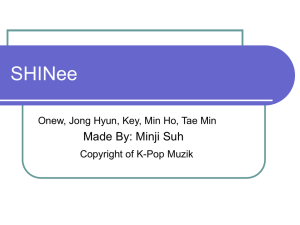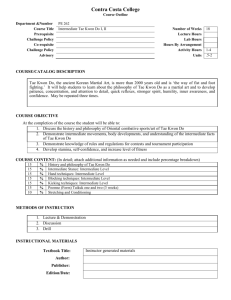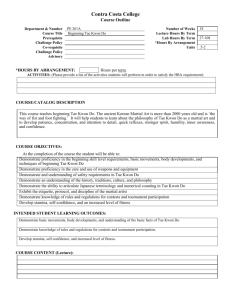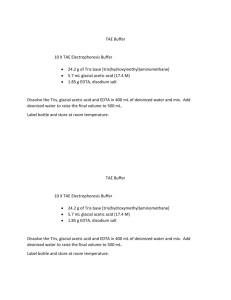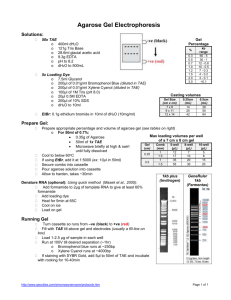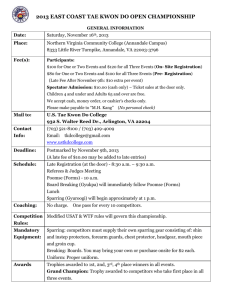MetricsAndGrammetrics
advertisement
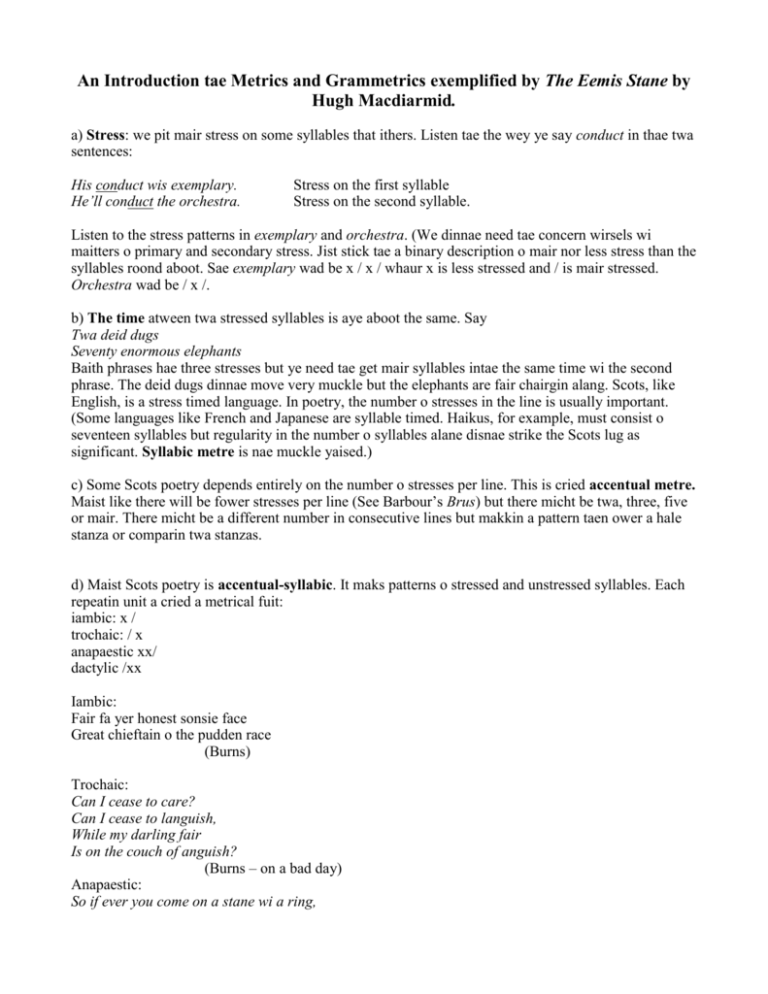
An Introduction tae Metrics and Grammetrics exemplified by The Eemis Stane by Hugh Macdiarmid. a) Stress: we pit mair stress on some syllables that ithers. Listen tae the wey ye say conduct in thae twa sentences: His conduct wis exemplary. He’ll conduct the orchestra. Stress on the first syllable Stress on the second syllable. Listen to the stress patterns in exemplary and orchestra. (We dinnae need tae concern wirsels wi maitters o primary and secondary stress. Jist stick tae a binary description o mair nor less stress than the syllables roond aboot. Sae exemplary wad be x / x / whaur x is less stressed and / is mair stressed. Orchestra wad be / x /. b) The time atween twa stressed syllables is aye aboot the same. Say Twa deid dugs Seventy enormous elephants Baith phrases hae three stresses but ye need tae get mair syllables intae the same time wi the second phrase. The deid dugs dinnae move very muckle but the elephants are fair chairgin alang. Scots, like English, is a stress timed language. In poetry, the number o stresses in the line is usually important. (Some languages like French and Japanese are syllable timed. Haikus, for example, must consist o seventeen syllables but regularity in the number o syllables alane disnae strike the Scots lug as significant. Syllabic metre is nae muckle yaised.) c) Some Scots poetry depends entirely on the number o stresses per line. This is cried accentual metre. Maist like there will be fower stresses per line (See Barbour’s Brus) but there micht be twa, three, five or mair. There micht be a different number in consecutive lines but makkin a pattern taen ower a hale stanza or comparin twa stanzas. d) Maist Scots poetry is accentual-syllabic. It maks patterns o stressed and unstressed syllables. Each repeatin unit a cried a metrical fuit: iambic: x / trochaic: / x anapaestic xx/ dactylic /xx Iambic: Fair fa yer honest sonsie face Great chieftain o the pudden race (Burns) Trochaic: Can I cease to care? Can I cease to languish, While my darling fair Is on the couch of anguish? (Burns – on a bad day) Anapaestic: So if ever you come on a stane wi a ring, Just sit yersel doon and apynt yersel King, For there’s nane wad be able tae challenge your claim That you crowned yersel king on the destiny stane. (Anon.) Dactylic: Aw the king’s horses and aw the kings man Couldnae pit Humpty thegither again. e) The first fuit o line is whiles inverted and first lines may be gey irregular but as ye read an accentualsyllabic poem ye get a feel o the metre and begin tae read tae the beat, but noo and again the poet will gie ye a line whaur the natural stress pattern disnae jist jeel wi the metrical stress. Extra stresses will slaw the line doon and extra unstressed syllables will speed it up. See (b). Tak guid tent tae the effects that poets create wi this ploy. The Eemis Stane x x / x / x x / x / I’ the how-dumb-deid o’ the cauld hairst nicht x / x x / x / The warl’ like an eemis stane 7 / x x / Wags i’the lift; x x / x / x / An’ my eerie memories fa’ x x / (/) / Like a yowdendrift. 10 syls 4 stresses 3 4 2 7 (8) 3 5 2 x x / x / x x / x / Like a yowdendrift so’s I couldna read 10 x / ?x ?/ x x / The wirds cut oot i’ the stane 7 x x / x / Had the fug o’ fame 5 x / x / x / An’ history’s hazelraw 6 (7) x / x / No’ yirdit thaim. 4 Hugh MacDiarmid (Sangschaw 1925) 4 3 2 3 2 Even taen at its maist metrical, the metre o this poem is gey unsettling; ye culd say the metre itsel is eemis. Atween the twa stanzas there is the repeatin pattern o stresses per line and apairt frae a couple o hypermetric lines (St 1 line 4 and St 2 line 3) The number o syllables per line repeats a pattern atween the stanzas. Hooiver, the distribution o stressed and unstressed syllables is irregular eneuch tae suggest that this is accentual mair nor accentual-syllabic metre. The beats are strang and gie the poem a chantlike or incantational quality. The ae dubious bit is cut oot but gien the resistance o maist speakers tae three equally unstressed syllables thegither, I wad be mair in favour o the stress faain on oot. By yaisin a structured but unpredictable arrangement o stresses, MacDiarmid braks awa frae the cliché o accentual-syllabic verse. The readers o poetry in the early twintieth century wad hae been expectin regular iambics, trochees, dactyls or anapaests; by brakkin awa frae these tae an aulder convention Macdairmid shaks up notions o time in mair weys nor ane. Time, metrically speakin, in The Eeemis Stane, muives in equal periods frae beat tae beat. This means that when there’s mair nor ane unstressed syllable comes atween the stresses, they need tae be pronoonced mair quick and this gies the perception that time is passin mair rapidly. Wi a single unstressed syllable in the same length o time, the speech seems tae slaw. Ye get nae chance tae settle tae ae speed in this poem. Tae this metrical discomfort is added the conflict atween metrical stress and sentence stress. Tae unnderstaun this difference, tak a luik for a moment at a line frae Alexander Pope’s Essay on Criticism: And ten low words oft creep in one dull line. This is an iambic line set in a lang and regular iambic poem and mony a reader wad hae nae bother wi readin it x / x / x / x / x / And ten low words oft creep in one dull line. But gin ye were readin this line oot o the context o the poem, ye wad pit stress on awthing except the in. Try it baith weys and see the effect. The iambic metre hops alang but pit in the extra stresses and the speed slaws richt doon. At this pynt in the poem, Pope is explainin that ‘the sound must seem an eccho to the sense’ and this line is a fine example o that. A guid reader maun hae a weel judged balance. Tae return tae MacDiarmid, readin The Eeemis Stane wi ordinary, everyday stress, maist readers wad pit stress on aw three elements o how-dum-deid, cauld haist nicht and yowdendrift. The alliteration o d gars ye ettle aw the mair tae haud on tae the dum and den syllables.It gies ye time as ye read tae enjoy and tak ful tent tae thae words, but mair nor that, it adds tae the hale dislocation o time in the poem. The rhyme scheme as weel avoids ony suggestion o cliché; its abcdc is eneuch tae suggest stanza demarcation but no eneuch tae set up expectations or predictability. Syntax and punctuation The first stanza is ae sentence wi twa co-ordinated clauses jyned by the conjunction and but separated by a semicolon. It is a conventionally constructit bit o syntax. The second stanza is nae sae straichtforrit. There isnae ony punctuation at the end o the first line o the second stanza but the line maks sense on its ain, as it staunds. He couldnae read for the snaw. Stert again and this time read on, tae discover that read is a transitive verb, wi the object the words cut oot i the stane. Again this could mak complete sense, but there is nae punctuation sae we read on and are pit aff wir stot by the verb had. We luik back tae find a subject for the verb and it taks a moment tae see whit the grammatical structure o the hale stanza really is. (Gin ye havenae unraivelt it yet, reorder the lines: (Even) Had the moss o fame And history’s lichen no’ buried them, I (still) couldna read the words cut oot i’ the stane.) Ye need tae stand back (in ooter space?) and get the hale picter o the stanza afore it maks sense grammatically. And even then, the first phrase, like a yowdendrift, had nae grammatical link tae the rest o the stanza. Macdiarmid is again deliberately challenging and unsettlin wir preconceptions. (A wee note on the vocabulary: we aw ken that he spent a fair time wi his neb in Jamieson’s Dictionary. Ah’ll nae say muckle aboot that, but the word lift is interestin. Auld English lift lost oot tae Auld Norse sky in baith Scots and English. Lift wis retaint as a poetic variant in English but it managed tae bide langer and mair widely in Scots. This is heelstergowdie tae the mair common (but nae universal) wey o daein whaur Scots is the ane maist likely tae shaw the influence o Auld Norse.) This craftsmanlike yiss o metre and syntax combines wi his rich, varied and aften mystical imagery, nae tae mention his orra vocabulary, tae mak some o his poetry fell obscure.. A gey few readers hae been content tae dook in the rare soond and jist be daein wi the bittockie o meanin that got through til them but the mair ye howk in McDiarmid, the better he gets. Ye’ll find that the mair ye look at the wark o the best poets, the mair ye find. Dinnae be pit aff if a poem luiks a bittie difficult at first glisk. Tyauve on!
